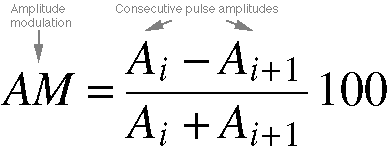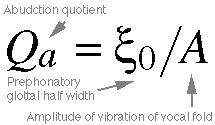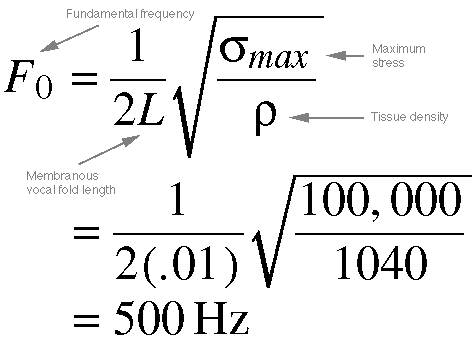Chapter 10:
Vocal Registers

Equation 10.1. This
equation calculates the time it takes
for formant energy (from the singers'
formant, at around 2800-3000 Hz) to 'die
out', which for our purposes is assumed
to be the time it takes for it to fade
to 1% of its original loudness; thus
the 0.01. B is the formant
bandwidth in rad/s, and t is the
decay time which we are solving for.

Equation 10.2. Here
we are solving for amplitude modulation,
the change in the deviation from equilibrium
between two cycles of vocal fold vibration.
We divide the difference between two
back-to-back cycles by the sum, and then
to get a percentage change, we multiply
by 100.

Equation 10.3. This
equation is just simple division, but
the variables could use some explanation.
The abduction quotient is what
we're solving for. The prephonatory
glottal half width is the distance
between the midpoint of the glottis and
the center of either vocal fold when
the folds are in a prephonatory position;
i.e. as open as they get during the type
of phonation being studied. A,
the amplitude of vibration, is the distance
between the midpoint of a vocal fold
and the edge of the part in vi bration.

Equation 10.4: Mean
aerodynamic driving pressure in the
glottis. (Same as Equation
4.13) Pi is the
pressure just above the glottis entering
the vocal tract. The value a2 over a1,
which is referred to as the glottal
convergence ratio, varies from
being near z ero when the folds are
just starting to open (tiny space between
the folds as they open means a small
exit area), to near 1.0 just before
the folds close. Since this value is
multiplied by the transglottal pressure
in our equation, this means that when
th e glottal convergence ratio is near
zero, it will tend to minimize the
whole right side of the equation. However,
when the convergence ratio is at its
maximum, the transglottal pressure (Ps-Pi) will
have more of an effect on t he pressure
in the glottis, Pg.

Equation 10.5.
This is a simplification
of Equation 10.4; if we assume that Pi equals
zero, we can drop the Pi terms
out of the equation. Since Pi is
the supraglottal pressure, which is affected
by the vowel the sing ers is producing,
this gives us an equation independent
of vowel.

Equation 10.6. (Same
as Equation 8-2) Here we try to
predict where a register 'break' might
occur based on known and assumed data
about the human voice. The maximum
TA activity is assumed to be 100 kPa
(100,000 pascals), tissue density is
1040 kg/m3, and the length
of the vocal fold in vibration is about
1 cm, which is .01 m. With these values
plugged into our equation, we get a
resulting Fo of about 500
Hz, which is right around C above middle
C. This is about as high that a belter
or trained classical tenor can pu sh
his/her chest voice.
Chapter
9 Equations Equations
Homepage Chapter
11 Equations
|



